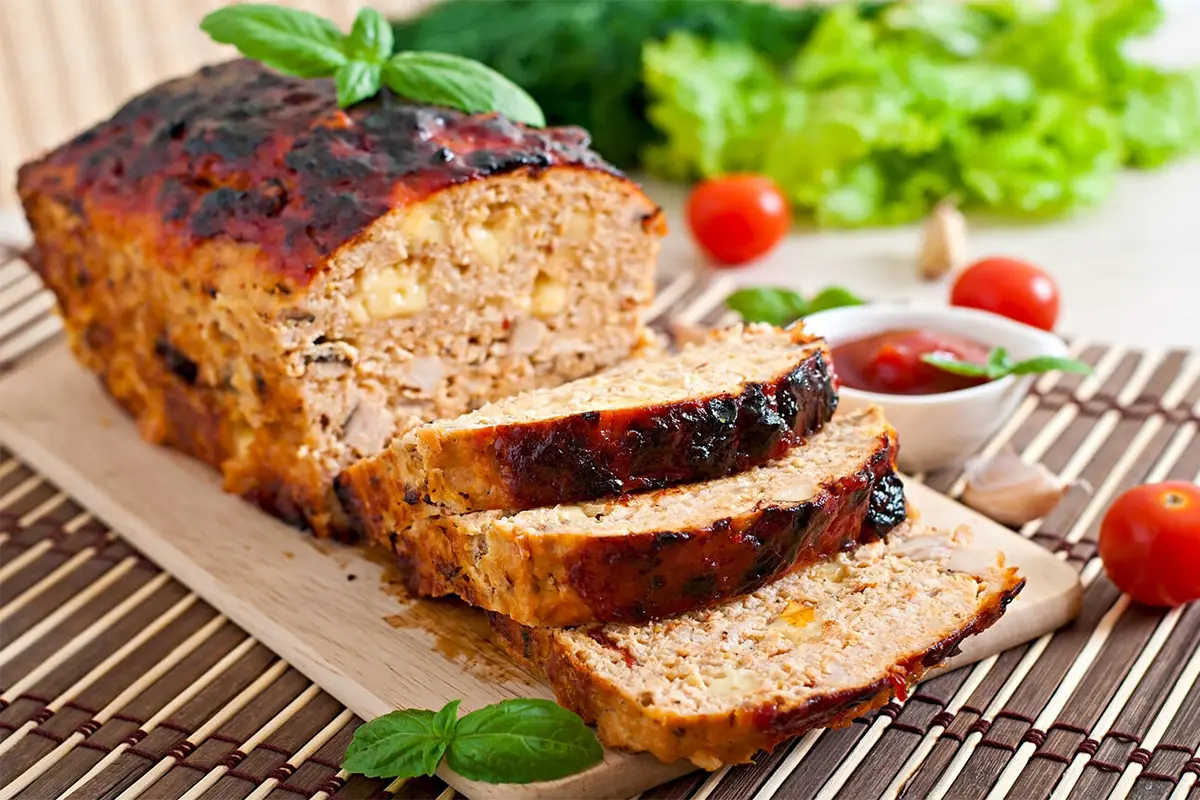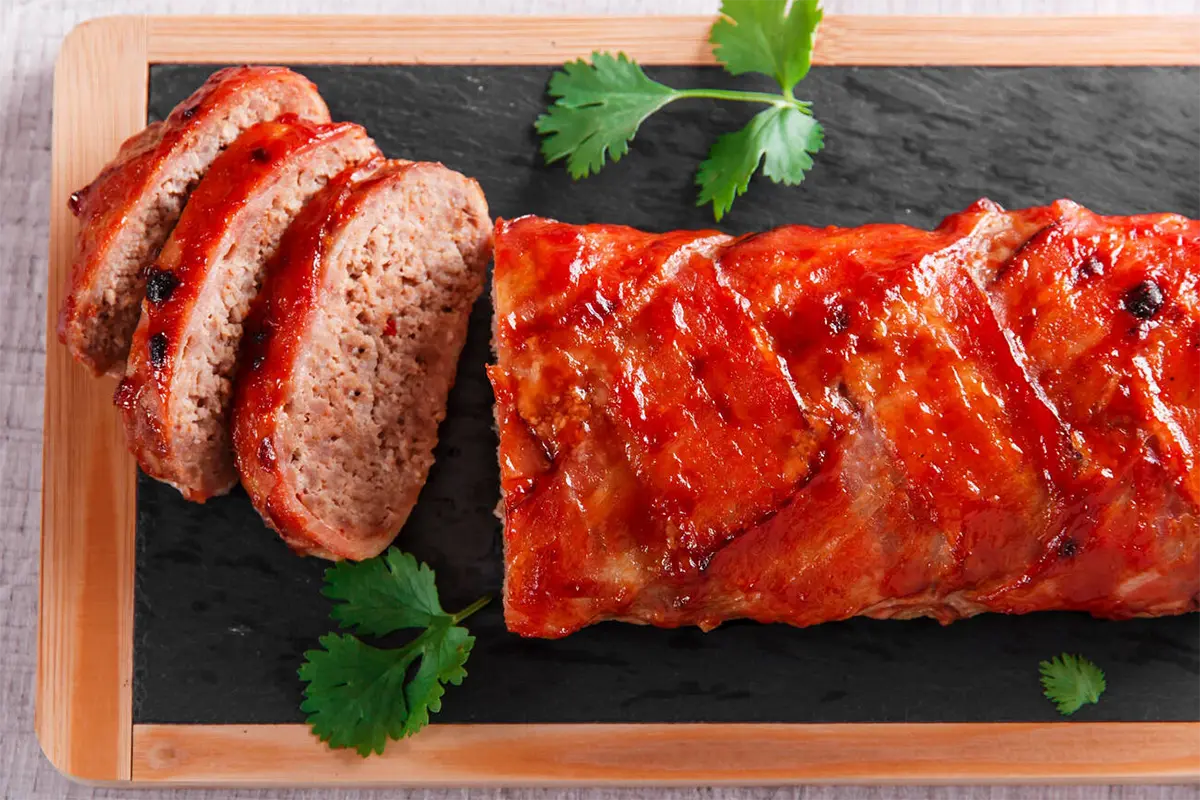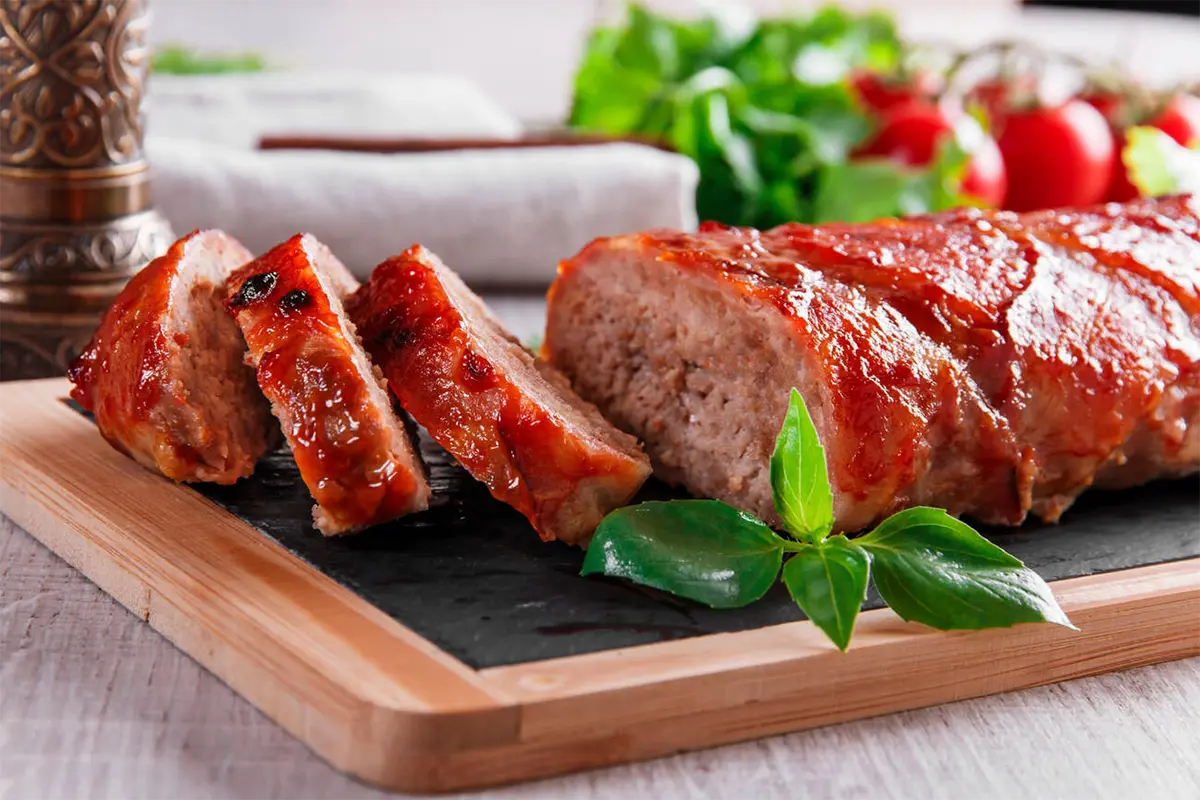Meatloaf shines as the ultimate comfort food, warming hearts and homes. Its savory flavors evoke cherished memories. Crafting tender, juicy meatloaf can seem elusive. We’re here to demystify making the perfect meatloaf. This article will explore selecting ingredients, mastering mixing, and the art of baking and glazing. Join this culinary journey to elevate your next meatloaf from good to legendary.
Discovering the secret to tender meatloaf promises to enhance your cooking skills and delight your taste buds. We’ll dive into meat selection, the role of each ingredient, and the art of mixing and shaping. This isn’t just meal preparation; it’s an experience. This guide to the secret to tender meatloaf will help you create a dish that’s a feast for the senses and a nod to tradition. Ready to find out the secret to tender meatloaf? Let’s start this flavorful quest, turning the perfect meatloaf dream into reality.
Introduction to Tender Meatloaf
The Ultimate Comfort Food: Tender Meatloaf
Meatloaf, the pinnacle of American comfort food, has roots in the Great Depression and remains a beloved staple. Its versatility and deliciousness have stood the test of time. But achieving that perfect tenderness can be a mystery. The secret to tender meatloaf lies in the blend of ingredients, mixing methods, and cooking techniques. It’s more than just a recipe; it’s about the harmony of all elements involved.
The journey to uncovering the secret to tender meatloaf involves selecting the right meats, adding moistening agents, and mixing gently. Each step is vital to the final texture and taste. This exploration pays tribute to meatloaf’s history while enhancing our cooking prowess. As we delve into the secret to tender meatloaf, we aim to turn basic ingredients into a culinary masterpiece, embodying the warmth of home-cooked meals. Let’s dive into mastering the secret to tender meatloaf, crafting a dish that’s not only satisfying but also rich in flavor and texture.
The journey of meatloaf from a budget-friendly meal to a cherished favorite demonstrates its incredible adaptability. Initially designed as a means to stretch limited meat resources with breadcrumbs and spices, meatloaf has now become a canvas for culinary creativity across the country. Indeed, its transformation is a testament to the dish’s enduring appeal and versatility.
The Quest for the Perfect Meatloaf Texture
Every meatloaf recipe seeks the perfect balance of moisture and flavor. Achieving this balance requires a mix of culinary skill and proven tips. From choosing the right meats to perfecting the mixing process, each step is essential for a superior meatloaf. Let’s explore how to make your meatloaf exceptional.
The secret to tender meatloaf goes beyond simple instructions; it’s about mastering cooking’s art and science. This journey into the secret to tender meatloaf highlights the significance of each ingredient and the techniques that enhance their benefits. These principles boost meatloaf’s flavor and texture, ensuring it’s a favorite at any meal. Join us in discovering the secret to tender meatloaf, transforming an ordinary dish into a remarkable culinary experience.
Essential Ingredients for Moisture and Flavor
Building Blocks of Flavor: Ingredients Deep Dive
When aiming for that perfect meatloaf, the right ingredients play a vital role. They bring not just flavor but also the desired tenderness to your dish. Let’s break down these essential components.
The Role of Vegetables
Vegetables are more than just a health boost for your meatloaf. They add moisture and depth to the flavor profile. Finely chopped onions, carrots, and bell peppers are popular choices. These veggies soften within the loaf, releasing their juices and ensuring the meat stays moist during cooking.
Choosing the Right Meats: A Blend for Tenderness
The meat choice is crucial for a tender meatloaf. A mix of ground beef and pork offers the best of both worlds. Beef lends the loaf a rich flavor, while pork adds fat, which means moisture. For an even juicier loaf, consider a part of ground veal. The key is balancing lean and fatty meats.
Importance of Wet Ingredients: Eggs, Milk, and Sauces
Eggs, milk, and sauces bind the meatloaf mixture and add moisture. Eggs keep the loaf from falling apart. Milk soaks into the breadcrumbs, expanding them within the loaf to make it tender. Don’t forget the sauces! Ketchup, mustard, and Worcestershire sauce pack a flavor punch and ensure the meatloaf isn’t dry.

The Meatloaf Mix: Achieving the Perfect Texture
Mixing Matters: Techniques for a Tender Loaf
Crafting a tender meatloaf demands careful mixing. The goal is to combine ingredients without overworking the meat. Here’s how to ensure a tender, juicy loaf.
The Art of Mixing: Keeping It Light
To mix meatloaf ingredients properly, use a light touch. Start by combining the wet and dry ingredients before gently folding in the meat. This method prevents the proteins in the meat from becoming too compact. It results in a softer, more tender loaf. Remember, mixing by hand is best to gauge the texture.
Bread Crumbs: Binding Without Density
Bread crumbs play a key role in meatloaf. They bind the ingredients together and absorb moisture. For a lighter loaf, soak the breadcrumbs in milk first. This step creates a more tender texture by expanding the crumbs within the loaf. Choose fresh breadcrumbs over dry for even better results.
Shaping and Cooking: Tips and Tricks
Shaping and Baking Your Meatloaf to Perfection
Achieving the perfect meatloaf involves more than just mixing the right ingredients. How you shape and cook it plays a crucial role too. Follow these tips for a loaf that’s cooked evenly and tastes delicious.
Shaping the Loaf: Secrets to an Even Cook
Shape your meatloaf with care. A uniform shape ensures even cooking. Avoid making it too thick; a loaf that’s about 2 inches tall cooks best. Use wet hands to prevent sticking. This approach ensures a smooth surface, reducing the chance of cracks.
Baking Techniques: Time and Temperature
Baking your meatloaf at the right temperature is vital. A moderate oven, around 350°F (175°C), is ideal. This temperature cooks the meatloaf thoroughly without drying it out. Most loaves will need about an hour in the oven. Use a meat thermometer to check for doneness—160°F (71°C) means it’s ready.
The Role of the Cooking Vessel
The choice of pan affects your meatloaf’s texture and moisture. Baking in a loaf pan traps juices but can make the bottom soggy. For a firmer, browned crust all around, shape the loaf and place it on a baking sheet. This method allows fat to drain away, improving texture and flavor.
The Glaze: A Flavorful Finishing Touch
Glazing for Greatness: A Symphony of Flavors
A glaze elevates meatloaf from good to unforgettable. It adds moisture, flavor, and a shiny finish. Let’s explore some options for that final touch.
Classic Glaze Recipes
A traditional glaze mixes ketchup, brown sugar, and mustard. This combo offers a perfect balance of sweetness and tanginess. Simply spread it over the loaf before the last 15 minutes of baking. This timing allows the glaze to caramelize without burning.
Innovative Glazes to Try
For a twist, try new glaze recipes. Mix cranberry sauce with a bit of orange zest for a fruity glaze. Or, blend barbecue sauce with honey for a smoky sweetness. Brushing these on your meatloaf adds unique flavors that can make your dish stand out. Experiment to find your favorite!
The Best Meat Choices for Meatloaf
Selecting the Best Meats for Moist and Tender Meatloaf
Choosing the right meat is crucial for a delicious meatloaf. The meat not only defines the flavor but also affects the texture. Let’s dive into the best options.
Ideal Meat Blends
For a flavorful and moist meatloaf, mixing meats is key. A popular choice is a blend of ground beef and pork. This mix offers both rich flavor and juiciness. Another great option is a combination of beef, veal, and pork. This trio brings a balance of taste, tenderness, and moisture to the table.
Lean vs. Fat: Finding Balance
The secret to a tender meatloaf lies in the fat content. Lean meats make the loaf dry, while too much fat can make it greasy. Aim for a mix where about 20% of the blend is fat. This ratio ensures the meatloaf stays moist and flavorful without being oily. Remember, the right balance of lean and fat is the ticket to a perfect meatloaf.
The Recipe: Ingredients, Directions, and Advice
Step-by-Step Guide to the Ultimate Meatloaf Recipe
Creating the perfect meatloaf doesn’t have to be a mystery. Follow this guide for a foolproof dish that’s sure to impress.
Ingredients List
- 1 pound ground beef (80% lean)
- 1/2 pound ground pork
- 1 cup fresh breadcrumbs
- 1/2 cup milk
- 1 small onion, finely chopped
- 1 carrot, grated
- 2 cloves garlic, minced
- 2 eggs, beaten
- 2 tablespoons ketchup
- 1 tablespoon Worcestershire sauce
- 1 teaspoon salt
- 1/2 teaspoon black pepper
- For the glaze:
- 1/2 cup ketchup
- 2 tablespoons brown sugar
- 1 tablespoon mustard
Detailed Cooking Directions

- Preheat your oven to 350°F (175°C).
- Soak breadcrumbs in milk until absorbed, about 5 minutes.
- Mix onion, carrot, garlic, eggs, ketchup, Worcestershire sauce, salt, and pepper in a large bowl.
- Add soaked breadcrumbs and meats to the bowl. Mix gently with your hands until just combined.
- Shape the mixture into a loaf on a baking sheet.
- Bake for 1 hour. Meanwhile, mix the glaze ingredients.
- Glaze the meatloaf and bake for another 15 minutes.
- Let it rest for 10 minutes before slicing.
Expert Tips for Best Results
- Gently mix the ingredients to avoid a dense meatloaf.
- Letting the meatloaf rest after baking makes it easier to slice.
- Experiment with the glaze for different flavors.
- Use a meat thermometer to ensure it’s cooked to 160°F (71°C).
With these steps and tips, you’re well on your way to making a tender, flavorful meatloaf that’ll become a go-to in your recipe collection.
Serving and Storage
From Oven to Table: Serving Suggestions and Storage Tips
Once you’ve mastered the art of meatloaf, serving it right and storing leftovers properly will ensure it remains a favorite.
Perfect Pairings: Side Dishes to Complement Meatloaf
A slice of meatloaf goes well with various sides. Mashed potatoes offer a creamy texture that pairs beautifully with the meatloaf’s richness. Green beans or roasted carrots add a pop of color and a crunchy texture to your plate. For a lighter option, a fresh salad brings a refreshing contrast. Together, these sides round out the meal perfectly.
Storing and Reheating Leftovers
Storing leftovers properly keeps meatloaf tasty for days. Wrap it tightly in foil or place it in an airtight container in the fridge. It will stay good for up to four days. For reheating, a low oven or microwave works well. Add a splash of water or broth to keep it moist. This way, the meatloaf remains as delicious as it was fresh out of the oven.
With these tips for serving and storage, you can enjoy your meatloaf to the fullest, from the first slice to the last.
FAQs Section
How can I ensure my meatloaf doesn’t come out dry?
To keep your meatloaf moist, use a mix of meats, including some with a higher fat content. Adding soaked breadcrumbs and vegetables like onions and carrots also helps. Lastly, don’t overcook it. Use a meat thermometer to check for doneness without guessing.
Can I substitute beef with other meats for my meatloaf?
Absolutely! Ground turkey, chicken, or lamb can replace beef. Each brings its unique flavor. Mixing different meats, such as pork and veal, with your choice can enhance juiciness and taste.
What are some creative glaze ideas for meatloaf?
Experiment beyond the classic ketchup-based glaze. Try combining barbecue sauce and honey for a sweet and smoky flavor. A mix of balsamic vinegar and brown sugar offers a tangy twist. For something bold, mix Sriracha with apricot jam for a spicy kick.
How long should I let my meatloaf rest before serving?
Let your meatloaf rest for about 10 minutes after taking it out of the oven. This resting period allows the juices to redistribute, making the meatloaf moist and easier to slice.
Conclusion
Your Meatloaf Questions Answered & Final Thoughts
Making tender meatloaf is an art that combines the right ingredients, mixing, and cooking techniques. Today, we’ve explored how to select meats, mix ingredients gently, and cook your loaf to perfection. Remember, the key to a moist meatloaf lies in not overworking the mix, using a blend of lean and fatty meats, and cooking at the right temperature.
Concluding Insights on Achieving Tender Meatloaf
Achieving the perfect meatloaf requires a balance of flavors and moisture. Start by selecting a blend of meats that suits your taste preferences and dietary needs. Incorporate ingredients like breadcrumbs and eggs, which help in binding the mixture while retaining moisture. Pay close attention to cooking techniques; avoid overmixing and overcooking, as these can lead to a tough and dry loaf. Experiment with glaze recipes to add an extra layer of flavor that complements the meat. Serving suggestions vary, but meatloaf pairs well with a wide range of side dishes, enhancing its appeal as a versatile comfort food. For storing leftovers, wrap the meatloaf tightly to maintain its moisture and flavor for future enjoyment. With these insights, you’re well-equipped to create a tender, moist meatloaf that will comfort and satisfy.
LSI and NLP Keywords
- Comfort food, meat blend, moist meatloaf, glaze recipes, cooking techniques, meatloaf ingredients, shaping meatloaf, meatloaf serving suggestions, storing meatloaf, meatloaf
External Links and Recommended Anchor Text
- Better Homes & Gardens – For timeless kitchen wisdom and recipe ideas.
- Foodess – Visit here for a unique take on traditional meatloaf recipes.
- Today – For expert tips on making perfect meatloaf every time.

